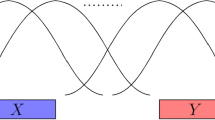Abstract
In this work we review the derivation of Dirac and Weinberg equations based on a “principle of indistinguishability” for the (j,0) and (0,j) irreducible representations (irreps) of the homogeneous Lorentz group (HLG). We generalize this principle and explore its consequences for other irreps containing j≥1. We rederive Ahluwalia–Kirchbach equation using this principle and conclude that it yields \(\mathcal{O}(p^{2j} )\) equations of motion for any representation containing spin j and lower spins. We also use the obtained generators of the HLG for a given representation to explore the possibility of the existence of first order equations for that representation. We show that, except for j=\( - \frac{1}{2}\), there exists no Dirac-like equation for the (j,0)⊕(0,j) representation nor for the (\( - \frac{1}{2}\),\( - \frac{1}{2}\)) representation. We rederive Kemmer–Duffin–Petieau (KDP) equation for the (1,0)⊕(\( - \frac{1}{2}\),\( - \frac{1}{2}\))⊕(0,1) representation by this method and show that the (1,\( - \frac{1}{2}\))⊕(\( - \frac{1}{2}\),1) representation satisfies a Dirac-like equation which describes a multiplet of \(j = \frac{3}{2}{\text{ and }}j = \frac{1}{2}\) with masses m and m/2, respectively.
Similar content being viewed by others
References
K. Johnson and E. C. Sudarshan, “Inconsistency of the local field theory of charged spin-3/2 particles, ” Ann. Phys. 13, 126(1961).
R. D. Peccei, “Chiral Lagrangian calculation of pion-nucleon scattering lengths, ” Phys. Rev. 176, 1812(1968). R. D. Peccei, “Chiral Lagrangian model of single-pion photoproduction, ” Phys. Rev. 181, 1902 (dy1969). G. Velo and D. Zwanziger, “Propagation and quantization of Rarita–Schwinger waves in an external electromagnetic potential, ” Phys. Rev. 186, 1337 (dy1969). C. R. Hagen and W. J. Hurley, “Magnetic moment of a particle with arbitrary spin, ” Phys. Rev. Lett. d24, 1381 (1970). C. R. Hagen, “New inconsistencies in the quantization of spin-3/2 fields, ” Phys. Rev. D d4, 2204 (1971). F. Jones and M. Scadron, “Multipole γNδ form factors and resonant photo-and electroproduction, ” Ann. Phys. 81, 1 (1973). M. El Amiri, J. Pestieau, and G. López Castro, “Delta ++ contribution to the elastic and radiative π+P scattering, ” Nucl. Phys. A 543, 673 (1992). G. López Castro and A. Mariano, “Determination of the δ++ magnetic dipole moment, ” Phys. Lett. B 517, 339 (2001). M. Hernandez, J. L. Lucio, and G. López Castro, “ω- → λKγ and the Omega magnetic moment, ” Phys. Rev. D 44, 794 (1991). V. M. Villanueva, J. A. Nieto, and O. Obregon, “Non-minimal coupling for spin-3/2 fields, ” Rev. Mex. Fis. 48, 123 (2002).
L. M. Nath, B. Etemadi, and J. D. Kimel, “Uniqueness of the interaction involving spin-3/2 particles, ” Phys. Rev. D 3, 2153(1971).
S. Weinberg and E. Witten, “Limits on massless particles, ” Phys. Lett. B 96, 59(1980).
J. Gasser and H. Leutwyler, “Chiral perturbation theory: Expansions in the mass of the strange quark, ” Nucl. Phys. B 250, 465(1985).
J. Gasser, M. E. Sainio, and A. Svarc, “Nucleons with chiral loops, ” Nucl. Phys. B 307, 779(1988).
E. Jenkins and A. V. Manohar, “Baryon chiral perturbation theory using a heavy fermion Lagrangian, ” Phys. Lett. B 255, 558-562 (1991).
E. Jenkins and A. V. Manohar, “Baryon chiral perturbation theory, ” UCSD-PTH-91-30, Proceedings, Workshop on Effective Field Theories of the Standard Model, Dobogoko, Hungary, August 22–26, 1991, U. G. Meissner, ed. (World Scientific, Singapore, 1992), pp. 113-137.
M. Napsuciale and J. L. Lucio, “Spin-3/2 interacting fields and heavy baryon chiral perturbation theory, ” Phys. Lett. B 384, 227-232 (1996). M. Napsuciale and J. L. Lucio, “Heavy baryon spin-3/2 theory and radiative decays of the decuplet, ” Nucl. Phys. B 494, 260-280 (1997).
S. Weinberg, “Feynman rules for any spin, ” Phys. Rev. B 133, 1318(1964).
S. Weinberg, The Quantum Theory of Fields. Vol. 1: Foundations (Cambridge University Press, Cambridge, 1995), p. 609.
L. H. Ryder, Quantum Field Theory (Cambridge University Press, Cambridge, 1985), p. 443.
D. V. Ahluwalia, M. B. Johnson, and T. Goldman, “A Bargmann–Wightman–Wigner type quantum field theory, ” Phys. Lett. B 316, 102(1993).
F. H. Gaioli and E. T. Garcia-Alvarez, “Some remarks about intrinsic parity in Ryder's derivation of the Dirac equation, ” Am. J. Phys. 63, 177(1995).
D. V. Ahluwalia, “Non-locality and gravity-induced CP violation, ” Mod. Phys. Lett. A 13, 3123(1998). D. V. Ahluwalia and M. Kirchbach, “Primordial space-time foam as an origin of cosmological matter-antimatter asymmetry, ” Int. J. Mod. Phys. D 10, 811 (2001) [arXiv:astro-ph/0107246]. D. V. Ahluwalia and M. Kirchbach, “Fermions, bosons, and locality in special relativity with two invariant scales, ” gr-qc/0207004.
H. J. Bhabha, “Equations with two distinct masses, ” Phil. Mag. 43, 33(1952); H. J. Bhabha Rev. Mod. Phys. 17, 200 (1945).
Harish-Chandra, “On relativistic wave equations, ” Phys. Rev. 71, 793-805 (1947).
D. V. Ahluwalia and M. Kirchbach, “(1/2, 1/2) representation space: An ab initio construct, ” Mod. Phys. Lett. A 16, 1377(2001).
W. J. Hurley and E. C. G. Sudarshan, “Algebraic study of a class of relativistic wave equation, ” Ann. Phys. 85, 546(1974).
N. Kemmer, Proc. Roy. Soc. A 173, 91(1939).
R. J. Duffin, “On the characteristic matrices ofcovariant systems, ” Phys. Rev. 54, 1114(1938). G. Petieau, Acad. R. Belg. Cl. Sci. Mem. Collect 8 16(2) (1936).
M. Nowakowski, “The electromagnetic coupling in Kemmer–Duffin–Petiau theory, ” Phys. Lett. A 244, 329(1998).
W. J. Hurley, “Relativistic wave equations for particles with arbitrary spin, ” Phys. Rev. D 4, 3605(1971).
Author information
Authors and Affiliations
Rights and permissions
About this article
Cite this article
Napsuciale, M. “Principle of Indistinguishability” and Equations of Motion for Particles with Spin. Foundations of Physics 33, 741–768 (2003). https://doi.org/10.1023/A:1025696823295
Issue Date:
DOI: https://doi.org/10.1023/A:1025696823295



